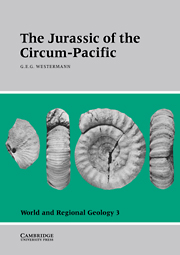Book contents
- Frontmatter
- Contents
- List of contributors
- Preface
- Acknowledgments
- Introduction
- Part I Time scales
- Part II Circum-Pacific base map
- Part III Regional geology and stratigraphy
- Part IV Biochronology
- Part V Biogeography
- Part VI Climatology and oceanography
- Appendix: Biochronology and atlas with index and guide fossils
- General Index
- Index of Guide- and Indexfossils
Introduction
Published online by Cambridge University Press: 04 August 2010
- Frontmatter
- Contents
- List of contributors
- Preface
- Acknowledgments
- Introduction
- Part I Time scales
- Part II Circum-Pacific base map
- Part III Regional geology and stratigraphy
- Part IV Biochronology
- Part V Biogeography
- Part VI Climatology and oceanography
- Appendix: Biochronology and atlas with index and guide fossils
- General Index
- Index of Guide- and Indexfossils
Summary
The Jurassic period is of particular significance for a variety of geological and biological disciplines: Not only has it served as the “classical” example for biostratigraphy and chronostratigraphy, but also it marked the beginning of the last megacycle of plate movements, that is, the “final” breakup of Pangea. The history of the Pacific Ocean (with its ancestor, Panthalassa) and the motions of the multitudinous suspect/tectonostratigraphic terranes now surrounding it can be traced back to the Jurassic, which formed the oldest extant ocean floor. Palinspastic reconstructions by geophysicists are required for the Jurassic paleogeography of the Pacific rim, because most of the current continental margins were, at that time, islands or submarine plateaus (terranes) within the single ocean (Panthalassa). Paleobiogeography provides limits to the geophysical placements of the terranes, especially for Northern Hemisphere versus Southern Hemisphere alternatives and narrowly spaced blocks and terranes forming isthmuses or seaways for faunal migration.
The essential condition for reconstructing a detailed Jurassic history of the Pacific rim is, of course, a precise time correlation between the distant autochthonous (craton) and allochthonous (terranes) Jurassic sequences. In addition to the development of radiometric and magnetic time scales, the construction of refined biostratigraphic regional zonations is essential. In general, ammonite zones remain by far the most practical, precise means for defining and identifying coeval chronostratigraphic units, not only between Pacific regions but also globally. Other plant and animal taxa are becoming increasingly important for biostratigraphy and biogeography, and a multitaxial, integrated approach is beginning to develop.
- Type
- Chapter
- Information
- The Jurassic of the Circum-Pacific , pp. 1 - 2Publisher: Cambridge University PressPrint publication year: 1993



